Enhance User Experience and Drive Web Traffic With Receptive Website Design
In today's digital landscape, where users are accessing sites from a multitude of devices, responsive web layout has actually come to be a lot more vital than ever. With its capability to adapt and effortlessly change to different screen dimensions, receptive style not just improves user experience but also drives traffic to your web site.
Why Responsive Internet Design Matters
Responsive internet design is a vital facet of modern web advancement as a result of its capacity to guarantee optimal individual experience across numerous gadgets and display dimensions. With the proliferation of mobile phones, tablet computers, and various other smart phones, it has become vital for sites to adapt and give seamless capability no matter of the tool being utilized.
The key factor why responsive website design matters is that it permits users to have a constant and satisfying surfing experience, no matter the gadget they are utilizing. A receptive web site instantly changes its material, layout, and layout aspects to fit the screen size and resolution of the gadget, guaranteeing that individuals can easily browse and interact with the site without any hassle or aggravation.
Additionally, receptive website design also plays a significant duty in search engine optimization (SEO) Look engines, such as Google, prioritize web sites that are receptive and mobile-friendly in their search engine result. By incorporating responsive layout concepts, web sites can improve their presence and position, causing raised organic traffic and possible clients.

Boosting Individual Involvement Through Responsive Design
Enhancing individual interaction is a vital goal of responsive style, as it ensures that users can quickly gain access to and connect with website material on any type of tool. With the enhancing usage of tablet computers and smartphones, it is critical for websites to adapt to various display dimensions and resolutions. Receptive layout enables internet sites to automatically adjust their design and material to supply a seamless individual experience across devices.
One of the primary means responsive design enhances user involvement is by reducing load times. With a receptive site, customers do not need to wait on separate mobile versions to load, resulting in faster accessibility to web content. This enhanced speed results in higher customer satisfaction and encourages them to invest more time on the site.
Additionally, responsive layout boosts individual interaction by enhancing navigation and interface (Web Design). When a website is designed responsively, food selections and switches are optimized for touch communications, making it much easier for customers to engage and browse with the website on their mobile phones. This easy to use and user-friendly experience keeps users engaged and urges them to check out more of the web site
Additionally, receptive style permits far better material presence and readability. By adapting the format and font style sizes to different gadgets, receptive web sites ensure that customers can quickly understand the content and check out. This improves customer interaction by reducing the demand for zooming or scrolling to review the text.
Increasing Web Site Website Traffic With Responsive Website Design
With the growing popularity of mobile phones, having a site that is receptive to different screen sizes and resolutions is crucial for driving increased traffic. In today's digital landscape, individuals are accessing sites from a variety of gadgets such as smartphones, tablets, and home computer. Each of these gadgets has different screen dimensions and resolutions, and if your website is not developed to adapt to these variations, it can lead to an inadequate customer experience and a loss of potential traffic.
Receptive internet layout makes sure that your site looks and functions ideally throughout all gadgets. By utilizing flexible grids, liquid photos, and media inquiries, responsive layout allows your site to automatically adjust its web content, design, and navigation to fit any screen size. This indicates that users will certainly have a seamless browsing experience despite whether they are utilizing a large desktop or a tiny smartphone computer.
Key Components of Effective Responsive Design
Reliable responsive style includes several essential aspects that ensure a seamless individual experience throughout various devices. This allows material to be presented in a readable and aesthetically enticing fashion on any type of gadget.
An additional important aspect is media questions. These allow developers to apply various styles and formats based on the qualities of the user's gadget, such as screen dimension and positioning. By utilizing media questions, designers can maximize the discussion of content for each gadget, making certain that it is understandable and quickly available.
Responsive pictures are likewise vital in reliable receptive style. Pictures that are as well big can slow down page tons times on mobile gadgets, while images that are too small may appear pixelated on bigger displays. By making use of strategies such as receptive image resizing and lazy loading, designers can guarantee that pictures are suitably sized and optimized for each and every see this site gadget.
Finally, efficient receptive style includes a mobile-first method. This implies creating and prioritizing material for smart phones first, and after that improving the style and broadening for larger screens. This approach ensures that the most important content is easily obtainable on smaller sized displays, while still giving an website design includes abundant experience on bigger tools.
Best Practices for Applying Receptive Website Design
Carrying out receptive website design calls for cautious consideration of different best methods to guarantee an optimum individual experience throughout different tools. Here are some vital best methods to follow when carrying out receptive web layout.
First of all, it is essential to focus on mobile users. With the raising dominance of smart phones, developing for mobile-first has ended up being crucial. Beginning by designing for smaller sized displays and then considerably improve the format for larger displays.

One more crucial finest method is to maximize images for various display resolutions. Big pictures can decrease the packing time of your website, specifically on mobile devices with slower links. Usage responsive images that can be resized based upon the device's display resolution to enhance performance.
In addition, examination your internet site on various tools and screen dimensions to make certain a smooth and constant experience. There are various testing tools offered that can help you identify any kind of problems and make necessary changes.
Lastly, prioritize functionality and ease of access. Ensure that your web site is simple to browse, with concise and clear content. Ensure that your web site is obtainable to people with handicaps and adheres to access guidelines.
Conclusion
In conclusion, responsive internet design plays an essential function in improving customer experience and driving web traffic to websites. By This Site taking on responsive style principles, websites can make certain optimum seeing experiences throughout various tools, leading to raised user interaction.
Optimizing customer involvement is a vital goal of responsive style, as it makes certain that users can conveniently gain access to and communicate with web site content on any type of device. Responsive style allows sites to immediately change their design and content to provide a seamless user experience throughout tools.
Additionally, responsive design enhances user interaction by improving navigating and user interface.Responsive images are also vital in reliable responsive design. By adopting responsive style principles, web sites can ensure optimal watching experiences throughout different devices, leading to increased customer involvement.